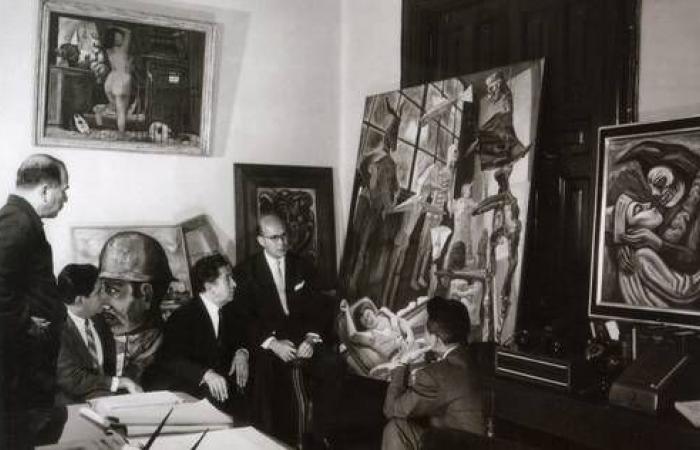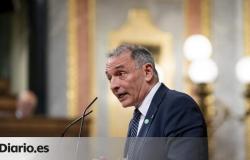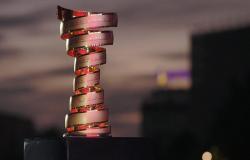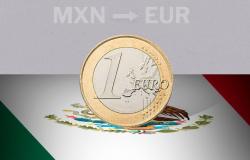Merry MacMasters
La Jornada newspaper
Wednesday, May 7, 2025, p. 2
The payment program in kind of the Ministry of Finance and Public Credit (SHCP) allows artists to cover their tax obligations through the delivery of their authorship. It is an innovative tax mechanism, unique in its kind. With this program, a representative collection of modern and contemporary art of the country has been formed.
This year is half a century of the presidential decree authorizing the SHCP Receive from artists that produce works of plastic arts independently, the payment of the entry tax of natural persons, which cause directly for such activity, with works of their production
. To commemorate the milestone, the institution prepares an exhibition, even without date, both documentary and work, for the SHCP Art Museum.
The background of the program date back to 1957, when a group of artists, headed by David Alfaro Siqueiros, asked the then director of the Income Tax, Hugo B. Margáin, the option of paying their taxes through plastic work of its authorship. In this regard, the official wrote in 1982 about the talk with the painter and muralist in which “the idea of allowing artists to pay their taxes through works of art was created.
“Siqueiros had organized a group of painters and one of them had been seized due to the lack of the payment of their income. By virtue of this system, collecting an important contemporary artistic collection and we would establish it in a museum especially made for the case.
The proposal was approved by the then Secretary Antonio Carrillo Flores and the artists’ response was enthusiastic. According to Margáin, Diego Rivera delivered his picture The artist’s study And shortly after three works corresponding to the final months of his life (he died on November 24, 1957): The Warsaw reconstruction worker, Urban landscape y Breaking the ice in Bratislava. Rivera’s contribution actually represented a donation, since he had no debts.
Rufino Tamayo delivered the painting The Fotogénica Venuswhile Adolfo Best Maugard sent his painting Zapata. Other artists such as Raúl Anguiano, Joaquín Martínez Navarrete and José Chávez Morado, among many more, had similar participation.
Success was increasing. Margáin points out: “The novel procedure was extended to recorders and sculptors, and it was so remarkable that educated countries in Europe came to portray the works delivered, initially exhibited in the Hall of SHC of the SHCP, and later in the Empress chapel. From this fate the beginning of an excellent Mexican contemporary art museum was formed.”
In the distance, the public official valued the results of the program: The contribution of artists in kind should also be considered as a stimulus to the contemporary national artistic movement. From the point of view of national interests you can ensure that this form of payment in kind, far from injuring the economic interests of the State, enriched it. All the works received then have a much greater value now than the artists owed to the treasury
.
The payment program in kind was formalized by means of a presidential decree published on March 6, 1975 in the Official Gazette. Among the criteria it was considered that Protect and increase the goods and values that constitute the cultural heritage of the Nation and make them accessible to the community constitutes one of the purposes of the educational social function
. To this end, The State should acquire a representative sample of the plastic arts, the work of Mexican or foreign authors who obtain taxable income from their artistic activity in the country
. To make the works acquired by the State accessible to the community, These must be exposed in rooms or museums to which the general public attends and exhibit them abroad as an example of the national artistic creation of our time
.
Although the collection of the program is mainly integrated by painting and sculpture, it has been modified to modernize its operation. Today it includes formats such as photography, installation, sound art and digital art.
Rigorous Selection of Vicente Rojo
Because the collection is the art presentation card that is made in the country, the creators registered in the program seek to send the best of their production. An example is Vicente Rojo (1932-2021). The painter, engraver and sculptor delivered his first work to the program in 1976, and not only remained active in it until his last days, but always selected his best pieces, he expressed The day In 2021 Nadia Hernández Serrano, Director of Collections Control of the General Directorate of the Conservatora de Palacio Nacional and Cultural Heritage of the SHCP.
We know that the teacher was a very disciplined artist and committed to his work, in addition to maintaining very high standards regarding his creation
Hernández Serrano said on the occasion of the exhibition A trajectory, a collection: Vicente Rojomounted at the Indian Station Cultural Center. The 48 pieces that the artist gave to the program over the years are organized from seven of the series that the artist worked throughout his life: Signals, Denials, Codices, Memories, Mexico in the rain, Scenarios y Volcanoes.






